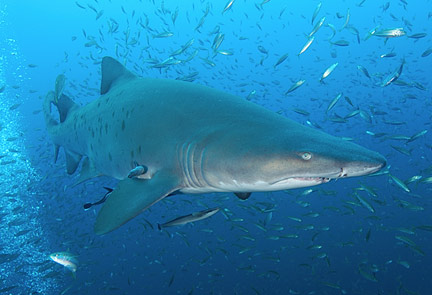|
|
|
SHARK INFO |
|
SHARK |
|
SHARK EVOLUTION |
|
|
|
SHARK DIVING |
|
SHARK DIVING 101 |
|
|
|
CONSERVATION |
|
|
|
PHOTOGRAPHY |
|
SHARK PHOTO TIPS |
|
|
|
RESOURCES |
|
|
|
WEB STUFF |
|
WHAT IS ELASMODIVER? Not just a huge collection of Shark Pictures: Elasmodiver.com contains images of sharks, skates, rays, and a few chimaera's from around the world. Elasmodiver began as a simple web based shark field guide to help divers find the best places to encounter the different species of sharks and rays that live in shallow water but it has slowly evolved into a much larger project containing information on all aspects of shark diving and shark photography. There are now more than 10,000 shark pictures and sections on shark evolution, biology, and conservation. There is a large library of reviewed shark books, a constantly updated shark taxonomy page, a monster list of shark links, and deeper in the site there are numerous articles and stories about shark encounters. Elasmodiver is now so difficult to check for updates, that new information and pictures are listed on an Elasmodiver Updates Page that can be accessed here:
|
|
_ |
|
THE SANDTIGERS OF NORTH CAROLINA
|
|
The seas off of the North Carolina coast are known as the Graveyard of the Atlantic. A combination of violent storms and wartime activity has left this region littered with twisted shipwrecks. Many of the wrecks are scattered and forgotten but those that hold their form create a magnet for marine life within the otherwise featureless terrain. Joining Eli and many new shark crazy friends, I was lucky to snatch two great days on the wrecks of the Papoose and the Carib Sea before the ocean boiled in the wake of Hurricane Francis. Arriving at Olympus Dive Centre on a sunny August afternoon we were told that the forecast was grim. Francis was on its way north from the Caribbean and due to make landfall on the Florida Coast at any minute. The following morning dawned clear, if not calm, and fighting the swells we made our way out to the Papoose and dropped in on some of the most ferocious looking sharks in the Atlantic. This oasis in the aquatic desert acts as a food factory for passing predators and large, intimidating Sandtiger sharks keep watch on all who come to feast. Anchoring in rolling seas, we are glad to get underwater into the relative calm of the ocean surge. The sharks are instantly visible. Famous for their menacing snaggle-tooth grins, these large powerful fish patrol back and forth above the wrecks. Each one has an entourage of thousands of silvery baitfish that form a molten cloak around their bodies. Occasionally the sharks twitch and shiver as though aggravated by the constant static from so many tiny electric fields. One by one the sharks saunter toward us. They move with a nonchalance that hints at power but they refuse to waste it on us. Wandering on, they draw distant circles around the wreck perhaps vaguely irritated by our intrusion so close to their larder. Heading off towards the bow I find myself alone with many large sharks and swim freely amongst them until my bubbles, or more likely my camera strobes, encourage them to drift away across the sand. Resisting the temptation to follow, I head back to find everyone engaged with their own group of sharks close to the anchor line. We ascend en masse and hang in the blue waiting to surface. The minutes tick slowly by until finally we are able to descend once more and repeat the experience. The next day we drop down into the belly of the Carib Sea through a bitter thermocline to where the clear blue water turns to plankton-heavy soup. Down here the sharks materialize like phantoms on a ghost ship. Visibility maxes out at 2 meters and finding each section of wreck becomes a pointless challenge for a photographer looking for shark portraits. I kick back into the light and watch Eli swimming with an 8ft female Sandtiger while videographer Raffa Flores floats eye to eye with another large individual that hovers in front of him suspended in space. Their large oil filled livers, combined with the unusual habit of gulping air at the surface, give these extraordinary sharks the ability to remain almost completely motionless without sinking to the sea floor. The divers (now experienced shark junkies) hold their position in the void rather than chasing the sharks and each is rewarded with many close encounters throughout the day. Trying to maintain position in the blue gray water with very little visual reference is a demanding activity and eventually each diver is forced to return to the ascent line. We hang with eyes cast downward to where the sharks with their grey-bronze backs ever shrouded in shimmering fish continue their leisurely circuits. Surfacing at the end of the second day we return to land as good friends and on that last journey home each diver offers up their prizes. Some have Sandtiger teeth they have plucked from the seabed, others have video and still images, and one or two divers simply have that look in their eyes that comes only from diving with sharks. Back to Elasmodiver Trip Reports Elasmodiver Home
|
























